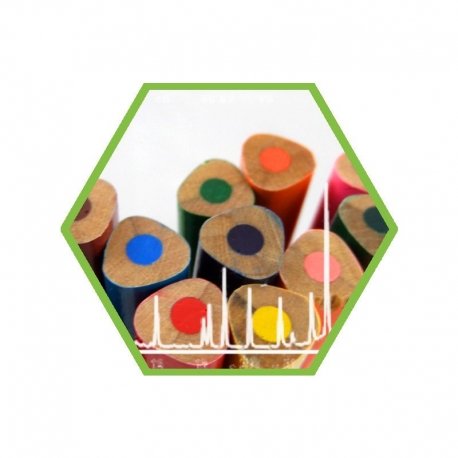{:de}

Buntstifte sollen Spaß machen – dieser Spaß wird durch Schadstoffe getrübt
Das Ausmalen von Malbüchern ist längst nicht mehr nur ein Spaß für Kinder. Auch für Erwachsene gibt es seit ein paar Jahren immer mehr Malbücher. Sie sollen der Entspannung dienen, eine kleine Auszeit vom stressigen Alltag.
Im 2. Ökotestheft 2017 wurde ein Bericht zu der Qualität von Buntstiften veröffentlicht. Untersucht wurden 20 verschiedene Fabrikate.
Am Ende war leider nur ein Produkt mit der Wertung „sehr gut“ und eins mit der Wertung „gut“ dabei. Die restlichen Produkte haben schlechter abgeschnitten. Getestet wurde neben Deckkraft, Anspitzverhalten und Brüchigkeit auch kritische Inhaltsstoffe.
Es wurden sowohl die Lackierung außen als auch die Minen der Holzmalstifte analysiert. Dazu hat man eine Methode verwendet, die eigentlich für Kleidung gedacht ist. Hintergrund dazu ist, dass man davon ausgehen kann, dass die Stifte, gerade von Kindern, auch mal in den Mund genommen werden oder die Schadstoffe über schwitzige Hände aufgenommen werden können.
Also hat man versucht diese Bedingungen nachzustellen und dazu bot sich die Extraktion an, die normalerweise bei Textitilen angewandt wird. Getestet wurde auf Weichmacher, aromatische Amine, Schwermetalle und die schwarzen Stifte auch auf PAK.
Gefunden wurden Weichmacher und Weichmacher Ersatzprodukte, aromatische Amine und in den schwarzen Buntstiften auch PAK. Viele dieser Substanzen sind giftig, dazu im folgenden mehr:
Weichmacher
Weichmacher werden in den Buntstiften verwendet um die Mine geschmeidig zu halten oder sie werden bei der Lackierung zugesetzt, damit der Lack nicht so schnell absplittert. Einige Weichmacher wirken hormonell und schädigen die Fortpflanzungsorgane. An dieser Stelle sind besonders das Dibutylphtalat (DBP) und das Diisobutylphtalat (DiBP) zu nennen, welche beide zu der Gruppe der Phthalate gehören.
aromatische Amine
Die aromatischen Amine werden häufig aus Azofarbstoffen freigesetzt. Azofarbstoffe sind lichtecht, farbstabil und in vielen Farben erhältlich. Ausgangsstoff für die Synthese von Azofarbstoffen ist das Anilin oder andere am Benzolring substituierte Derivate. In den getesteten Buntstiften wurde öfter Anilin nachgewiesen.
Unter bestimmten Voraussetzungen kann der Azofarbstoffe die Ausgangssubstanz Anilin wieder freisetzen. Anilin ist ein starkes Blutgift. Es verbindet sich mit dem Hämoglobin, welches im Körper für den Sauerstofftransport zuständig ist und verändert das Molekül so, dass es keinen Sauerstoff mehr transportieren kann.
Polyaromatische Kohlenwasserstoffe
Polyaromatische Kohlenwasserstoffe (PAK) gehören zu den Umweltgiften. Die Gruppe der PAK umfasst mehrere hundert Verbindungen. Viele dieser Verbindungen stehen in Verdacht, Krebs auszulösen.
Diese Analysen bietet my-lab International an:
 |
Weichmacher / Phthalate (SVHC) in MaterialMCSV1 Downloads: |
 |
Material/Kunststoff/Textilien: PAK (EPA)MPAH2 Downloads: |
 |
Aromatische Amine in MaterialMAR01 Downloads: |
Bildnachweise
- Titelbild | Quelle: my-lab International | Modifiziert von my-lab International
{:}{:en}

Coloured pencils should be fun – this fun is clouded by harmful substances
Colouring coloring books is no longer just fun for children. There have also been more and more colouring books for adults in recent years. They are intended for relaxation, a short break from stressful everyday life.
A report on the quality of crayons was published in the 2nd Ecotestheft 2017. 20 different makes were tested.
Unfortunately there was only one product with the rating “very good” and one with the rating “good” at the end. The remaining products performed worse. In addition to opacity, sharpening behaviour and brittleness, critical ingredients were also tested.
Both the exterior paintwork and the leads of the wooden crayons were analysed. For this purpose, a method was used that is actually intended for clothing. The background to this is that one can assume that the pens, especially by children, can also be put in the mouth or that the harmful substances can be absorbed via sweaty hands.
As such an attempt was made to simulate these conditions, the extraction that is normally used for textitiles was the obvious solution. Tested for plasticizers, aromatic amines, heavy metals and the black pencils also for PAK.
Found were plasticizers and plasticizer substitutes, aromatic amines and in the black crayons also PAHs. Many of these substances are toxic, read more about them below:
plasticizer
plasticizer
plasticizers are used in the coloured pencils to keep the lead supple or they are added during painting to prevent the paint from splintering off so quickly. Some softeners have a hormonal effect and damage the reproductive organs. The dibutyl phthalate (DBP) and diisobutyl phthalate (DiBP), both of which belong to the group of phthalates, should be mentioned here in particular.
aromatic amines
aromatic amines
The aromatic amines are often released from azo dyes. Azo dyes are lightfast, colour-stable and available in many colours. The starting material for the synthesis of azo dyes is aniline or other derivatives substituted on the benzene ring. Aniline was found more often in the crayons tested.
Under certain conditions the azo dye can release the starting substance aniline again. Aniline is a powerful blood poison. It combines with the haemoglobin, which is responsible for the transport of oxygen in the body and changes the molecule so that it can no longer transport oxygen.
polyaromatic hydrocarbons
Polyaromatic hydrocarbons (PAHs) are among the environmental toxins. The PAH group comprises several hundred compounds. Many of these compounds are suspected of causing cancer.
my-lab International offers these analyses:
 |
Phthalates (SVHC) in materialMCSV1 |
 |
material: PAH (EPA)MPAH2 |
 |
aromatic amines in materialMAR01 |
Photo credits
- Cover | Source: my-lab International | Modified by my-lab International
{:}



